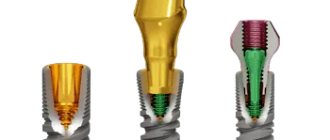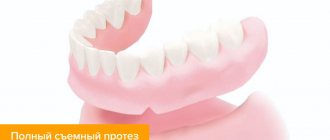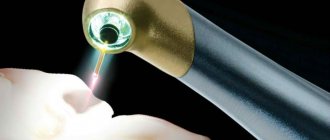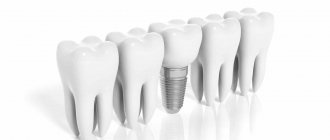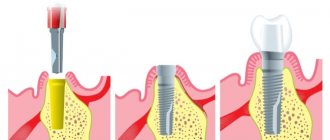Single-stage dental implantation is the implantation of a titanium root into the bone immediately after the removal of your tooth. In this case, bone augmentation is not required (as with the classical scheme), since after the removal of one’s tooth, the volume of hard tissue is quite sufficient. The procedure for implanting a titanium pin is performed in one visit to the dentist, but the patient will still have to visit the office several times: for diagnostics, replacing the temporary crown with a permanent one, and monitoring the healing process.
Basic conditions for immediate implantation
- sufficient volume of bone tissue;
- satisfactory condition of the gums and other dental units, absence of carious lesions and inflammatory processes;
- the presence of strong teeth near the implantation site, since during the healing of the implant, neighboring teeth will have to withstand a greater chewing load.
Note! Before the immediate installation of a new tooth, the patient must undergo a series of diagnostic measures so that the doctor can make sure of his health and physical resources for a quick recovery.
Doctor's advice: an implant can only be installed if the bone size is sufficient.
In all cases, the parameters of bone tissue are taken into account - density, height, width. Only when there is sufficient bone size can an implant be installed with a selected size and shape that can cope with chewing loads in the future. If there is not enough bone tissue, it is impossible to install the “correct” implant.
Levin Dmitry Valerievich
Chief physician, Ph.D.
If the bone dimensions do not correspond to the norm, preliminary osteoplasty is required, followed by installation of an implant according to the classical protocol. If the deficiency is small, a one-step bone augmentation and implant installation is possible.
A high-quality one-stage technique cannot be carried out in conditions of insufficient bone tissue. And it is also impossible to carry out bone augmentation at the same time - the operation is performed through a puncture, the doctor does not have access to the bone, he places the implant blindly.
In addition, with a one-stage protocol, the implant is immediately loaded with a temporary crown, which does not completely compensate for chewing functions. The implant cannot be actively used to avoid displacement. Full load is possible only after engraftment of the titanium root after 2-6 months, as with the classical method.
Complete restoration of chewing ability is no different for the classic and one-stage protocols. One-stage allows you to quickly hide an aesthetic defect, which is only relevant for the front teeth.
Classic implantation lasts longer, especially if the bone is previously built up. But the method is reliable and designed for long-term results:
- an implant of the correct shape and size is selected;
- before engraftment, it is sutured, overgrown with bone tissue, and not loaded—the risk of displacement during chewing is eliminated;
- during installation, the doctor sees the area of the operation and can perform manipulations to adapt the bone to future loads - this is impossible with immediate loading.
Indications and contraindications for simultaneous extraction and implantation of teeth
- restoration of one or more teeth;
- correction of dental problems in people whose professional activities involve constant contact with people;
- narrow ridge of the alveolar process, etc.
Note! There are many contraindications for performing the operation. Read them carefully and undergo a comprehensive examination to eliminate possible risks.
Main contraindications for immediate implantation:
- young age (up to 16 years);
- cancerous tumors;
- HIV AIDS;
- diseases of the heart and blood vessels;
- connective tissue diseases;
- diabetes;
- somatic diseases;
- diseases of the nervous system;
- renal failure;
- inflammatory processes in the body;
- viral infections;
- pregnancy;
- taking anticoagulants, etc.
Caring for single-phase implants
An important part of rapid rehabilitation and a means of extending the life of dental implants is proper care.
Maintaining oral hygiene prevents the development of pathogenic microorganisms leading to periodontal diseases and impaired implant fixation.
Be sure to brush your teeth in the morning and before bed with a suitable toothbrush and toothpaste. When choosing a brush, the main attention is paid to the softness, elasticity of the bristles, and gentle effect on gum tissue.
After meals, it is necessary to rinse your mouth with clean water, or it is better to use an irrigator that removes remaining food particles from hard-to-reach interdental spaces and the surface of the gums using a pulsating stream of water. Special solutions can be added to the irrigator water to help gently cleanse dental surfaces, relieve inflammation, and accelerate tissue healing.
Careful care of dentures and maintaining oral hygiene can significantly increase their service life.
During the first year after implantation, the patient must visit the dentist monthly to monitor the healing process.
Our experienced doctors will help you quickly and comfortably restore the beauty and health of your smile.
The main stages of simultaneous implantation
- Diagnostics and examination, testing, radiography.
- The dentist performs computer modeling of the future design, makes impressions, and sends the data to the dental laboratory.
- The patient comes for an appointment on the appointed day and is given anesthesia.
- The tooth is removed and a titanium pin is inserted into the resulting hole. Sutures are not applied in all cases - sometimes the wound heals on its own.
- There is a temporary crown on the aba.
- When the artificial root has completely taken root (after about 4 – 6 months), the permanent tooth is installed.
As you can see for yourself, the procedure is relatively time-consuming; the patient will still have to visit the clinic several times to get the ideal result. But in this case, the installation of an artificial root and tooth will take much less time than with the classical method.
Comparison of techniques
| Classical | One-stage | One-step | |
| Implant installation method | Flap - with peeling of the gum to access the bone | Transgingivally - through a puncture of soft and bone tissues | In the socket of an extracted tooth |
| Type of temporary prosthetics | A removable denture that is fixed to adjacent teeth | Temporary lightweight crown on an implant with bite relief | Removable denture or temporary crown on an implant |
| Duration of temporary prosthetics | 2-6 months before implant implantation | 2-6 months before implant implantation | 2-6 months before implant implantation |
| Formation of the gingival contour | Before permanent prosthetics | Not carried out | Depends on the type of prosthetics |
| Type of permanent prosthetics | Zirconium dioxide crown | Zirconium dioxide crown | Zirconium dioxide crown |
All three methods are painless, are performed under local anesthesia or sedation, and the patient does not feel any discomfort.
The same preparation is carried out, there is no difference in the required examinations. To identify contraindications, the following is carried out:
- taking anamnesis;
- inspection;
- CT scan.
The contraindications are the same:
- uncompensated diabetes mellitus;
- oncology;
- osteoporosis;
- bleeding disorders;
- tuberculosis;
- mental disorders.
But patients are more interested in the ability to quickly recover a lost tooth completely. According to this criterion, two methods differ - classical and one-stage. The one-stage method after removal is continued according to one of the protocols - with delayed or immediate loading.
One-stage dental implantation pros and cons
The advantages of one-step implantation of an artificial root include the following factors:
- speed of the procedure;
- comfort for the patient;
- the ability to replace an unhealthy tooth with a new, strong one in one session;
- there is no need to perform bone grafting;
- flawless results in one visit to the doctor.
Disadvantages of one-step tooth implantation:
- a large list of contraindications;
- considerable cost;
- with a small amount of bone tissue, the tooth may not stand securely (sometimes bone grafting cannot be avoided);
- the service life of the implant is about 20 years (among the classic analogues, you can select options with a longer service life);
- the structure must still take root - instantaneous loading is not recommended.
Three variants of one-step technology
When the implant is fixed in the patient’s jaw bone, the next phase begins. One of the following scenarios is possible:
- An abutment (an adapter between the implant and an artificial crown) is fixed onto the installed titanium root, and a temporary (plastic) prosthesis is placed on it. Upon completion of the osseointegration process (3–6 months), it is replaced with a permanent one made of metal ceramics or zirconium dioxide;
- the area where the implant was integrated is sutured and left in this form until the titanium rod is completely implanted. Then an incision is made and a permanent crown is installed;
- a gum former is attached to the fixed implant to create a neat contour (the so-called “pink aesthetics”), and if necessary, a temporary prosthetic structure is fixed.
Which implantation is better, classic or one-stage?
This question is best answered by a dentist who will undertake the operation to remove his tooth and insert a new one. The fundamental difference between a one-step procedure is the simultaneous installation of a new tooth. This method helps to solve the problem of missing teeth in the shortest possible time. Also, the classic procedure is quite traumatic and requires cutting soft tissue. If bone grafting is required, the period of classical implantation is significantly increased. However, the classic has many fewer contraindications than the one-step procedure.
Advantages.
1. The load on bone tissue occurs instantly. Accelerated loading promotes very rapid recovery, tissue adaptation is accelerated, and the artificial root is easily stabilized. 2. Prosthetics occurs through a small injection, thus the procedure can be called low-traumatic. 3. The prosthesis is implanted deep into the bone, which does not undergo atrophy, so the stabilization of the structure is very strong. 4. Has virtually no contraindications. 5. The dentition is restored in a very short time; the structure can be used immediately after the procedure. 6. Material rejection occurs in very rare cases. 7. The procedure has a relatively low price. 8. Single-phase implantation can be performed in patients with nicotine addiction. It should be remembered that this method of dental implantation can only be performed by a highly qualified prosthetist.
Single-phase implantation differs from the classical design of a monoblock implant, which is unique. It was created by many scientists and practitioners over several years of fruitful work. With the help of a monoblock implant, the patient can solve the most complex problems that the classical method, unfortunately, cannot solve.
Problems solved by single-phase implantation:
- The method of implant installation is low-traumatic. Its installation is carried out by making a small puncture of the gums. The classic method involves cutting the gums, 2 times. The first time the gum is cut is when the implant is implanted, the second time when the abutment is installed;
- Due to the fact that the single-phase method is low-traumatic, it is easily tolerated by absolutely all patients. After a single-phase procedure, of course, the patient experiences slight discomfort for some time, but not for long. During recovery after implantation, slight swelling may be observed for some time. It is relieved along with the discomfort using available painkillers. As a rule, after surgery, the doctor will select suitable painkillers on an individual basis;
- The patient returns to normal life immediately after the operation. Which is very important for busy people. It only takes 3-4 days to restore the entire oral cavity. With this method, a person can save a lot of time. Recovery using the classical method will take much longer;
- ,Another advantage of single-phase implantation is reliability. Single-phase implantation shows good results in terms of material rejection. It is only 3%. While classical implantation showed 5% rejection.
Like all medical procedures involving surgery, single-phase implantation has its own indications and contraindications.
Indications
The classic method of installing implants cannot offer its services to everyone for a number of reasons. The single-phase method is possible in many cases where the classical one is powerless.
The classical method is not possible if:
- AIDS;
- diabetes mellitus
- hepatitis C disease,
- for complex and advanced periodontal disease;
- bone atrophy.
These diseases cannot at all become a reason for failure to install a single-phase implant. In specific cases, only a doctor has the right to decide whether a procedure is possible for a certain disease. In most cases, a positive decision is usually made.
In addition, the classical method is very often forced to refuse services to people who abuse tobacco products. The single-phase method is completely accessible to this category of patients.
Another advantage of installing a monoblock implant is that after tooth extraction it is not necessary to wait for healing after the surgical wound. The implant can be implanted directly into a fresh wound. This significantly reduces recovery time.
A monoblock implant will correct the situation of a patient who has lost a tooth a long time ago and has a problem with bone atrophy. The design features of a single-phase implant allow it to be implanted at a suitable angle towards high-quality bone tissue, due to this the process of adhesion of the required strength occurs.
The procedure is not possible only if the bone has a loose structure. This pathology is detected during the initial examination of the patient.
Stages of the monoblock procedure
At the initial stage, you need to pass mandatory tests, undergo sanitation and examination of the oral cavity. If the patient has some problems with dental health, the problems are eliminated promptly. It is not possible to start restoring teeth if you have caries or gum disease. The initial stage cannot be ignored, since it is the main one, and a successful operation depends on it. Otherwise, rejection may occur, which is not at all desirable.
The next stage is the implantation itself. The doctor must determine how many implants need to be installed in order for the structure to be securely installed. Implants are installed vertically, in individual cases at an angle, for structural strength if there are problems with bone atrophy. After the structure has been implanted, the top of the implant will be elevated.
After 3 - 4 days, the next stage begins - installation of the prosthesis.
Risk of implant rejection
Such strict and numerous contraindications are prescribed to minimize cases of titanium implant rejection. Statistics say 2-4%, and this is a very small figure. But doctors are trying to completely exclude it.
The risks of implant rejection with a one-step technique may include:
- poor removal and severe trauma to the gums;
- plaque in the oral cavity - not only on the teeth, but also on the mucous membrane around the hole;
- weak fixation of the implant - porous bone tissue or other prerequisites;
- incorrect selection of a temporary crown and excessive load on the implant.
Results and reviews
The single-phase restoration method opens up wide possibilities for patients. Non-removable structures are installed on the titanium root. The aesthetics of the finished work are excellent - artificial teeth do not differ from “their own” ones in shape and shade.
Also, people who come to the dental clinic choose this technique due to its painlessness, speed of execution, and rapid tissue healing. To restore the integrity of the dentition, a small number of visits to a dental surgeon are necessary: the price of treatment becomes more profitable. If you still have questions about single-phase implantation, ask them to professionals by phone. Or sign up for a free initial examination and discuss all the nuances of the upcoming therapy with your dentist.
Single-phase Roott implantation
The Swiss brand produces more than a hundred types of structures used in restoration. The manufacturer offers various variations, taking into account:
- Severe anomaly of the alveolar process.
- Presence and degree of bone deficiency.
- Number of teeth to be restored.
- Desires for aesthetics.
For a monoblock procedure, the Compressive line is suitable, in which the implants are combined with an abutment. Implementation is possible immediately after destruction of the unit - restoration is carried out in a few days. The accelerated technique is popular in progressive countries and is gradually replacing classical implantations. If you are interested in single-phase implantation, turnkey technology prices will be provided by specialists from our clinic.
Indications for the procedure
For successful surgical treatment, certain conditions must be met:
- Missing one tooth in the smile area
- There are indications for tooth extraction
- Tooth root injury
Most often, removal is performed according to indications, and then an implant is installed and loaded with a crown. In this way, it is possible to reduce the entire treatment time from several months to one visit. For an aesthetically important area, this is the most effective method of restoring the dentition.
Contraindications
Contraindications to simultaneous implantation are:
- blood diseases, cancer;
- uncompensated diseases of the endocrine system;
- other chronic diseases in the acute stage.
Implantation is also not performed:
- during pregnancy;
- in the postpartum period;
- during lactation (breastfeeding).
Features of the technology
Single-phase dental implantation refers to the basal technique, but has a number of differences. The titanium root is immersed in the hard structures of the jaw and loaded on it in one phase. The introduction is carried out into the basal layer, which is not subject to atrophy and provides stabilization. A small puncture is required, there is no detachment of the mucous membrane, and no sutures are required.
Subsequently, during chewing, blood circulation is stimulated and tissue healing is accelerated. Restoring a row of teeth takes 3-4 days, the discomfort experienced is minimal. Residual pain syndrome is effectively relieved with medications.
Surgical manipulation is minimally traumatic, has no age restrictions and is suitable for most people, including nicotine-dependent citizens.




